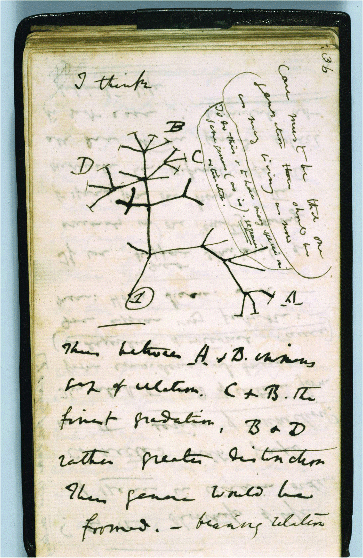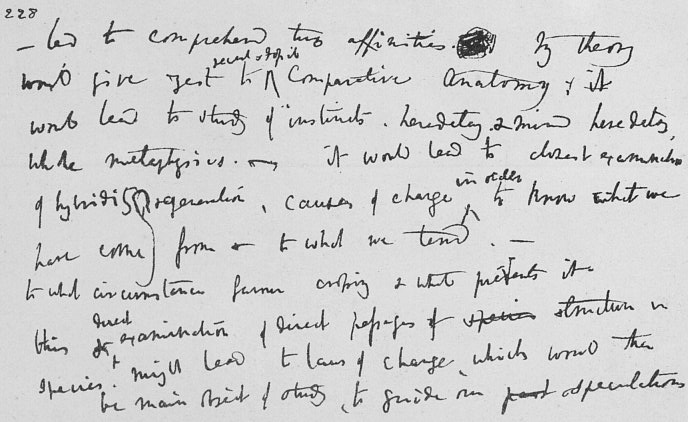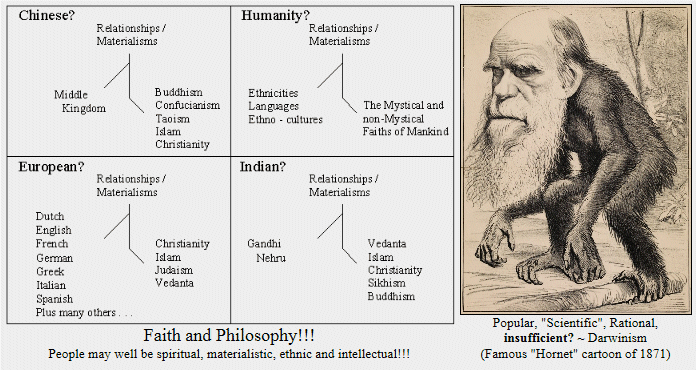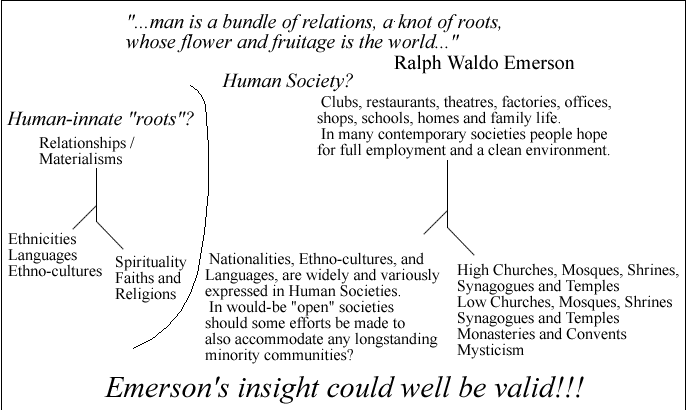The Tree of Life Sketch from
Charles Darwin's Notebook B, 1837
During the years away on the high seas and in distant lands the skeptical attidudes of many of his ship-mates and the various geological and biological phenomena he had witnessed had caused his mind to entertain critical doubts of the biblical explanations of Creation he had formerly fully accepted.
He continued to keep notebooks as he had on his voyages and, as early as 1837, in a Notebook B that the editors of Darwin's papers regard as being the notebook Darwin had specifically dedicated to his thought, during 1837 and into 1838, on the subject of the Transmutation of Species his theorising about the origin of species included his famous Tree of Life sketch.
 Charles Darwin's Tree of Life sketch shows his early theoretical
insight of how a genus of related species might
originate by divergence from a starting point (1).
Charles Darwin's Tree of Life sketch shows his early theoretical
insight of how a genus of related species might
originate by divergence from a starting point (1).Charles Darwin's - I Think - moment
The text annotations read:-
I think
Case must be that one generation then should be as many living as now. To do this & to have many species in same genus (as is) requires extinction.
Thus between A & B immense gap of relation. C & B the finest gradation, B & D rather greater distinction. Thus genera would be formed. - bearing relation (page 36 ends - page 37 begins) to ancient types with several extinct forms...
From Darwin's Notebook B now stored in Cambridge University library.

The personal evolution of Charles Darwin
Charles Darwin was born in 1809 and his initial Tree of Life sketch was penned in his notebooks in 1837 when he was in his later twenties.
He actually outlined, in pencil, initial thoughts and speculations related to a "Theory of Evolution" by 1842 - but put this multi-page documentation into storage, (to only be published after his death!), rather than face controversy, or scandal, (for himself and his family), by making it public in a theistic Victorian England accepting of Creationism.
Darwin inherited rather substantial wealth from his father, personally earnt money from authorship about The Voyage of the Beagle, whilst his wife came from the wealthy Wedgwood family of pottery-manufacturing renown.
It was only an approach by mail, from Alfred Russel Wallace, a relatively obscure Natural History specimen collector, who was then in living some far-flung region of south-west Asia, seeking Darwin's help in bringing theorising fairly identical to Darwin's own to the attention of Scientific circles in England, that led Darwin to prepare his own "Origin of Species" book for publication by 1859 - when Darwin was aged fifty.

The "Metaphysics" of - Human Being and Human Existence - are also considered on our site:-

N. B. Darwin elaborated significantly on his "Tree of Life" insight in his seminal work 'On the Origin of Species' as first published in 1859.
ALSO FROM NOTEBOOK B OF 1837!!!
The above "Tree of Life sketch" appears on page 36 of the notebook - the first 35 pages being effectively taken up by Darwin's consideration of his grandfather Erasmus Darwin's earlier evolutionary as published in Zoonomia; or the Laws of Organic Life (1794) a two-volume medical work dealing with pathology, anatomy, psychology, and the functioning of the body.Erasmus Darwin's work includes the following passage:-
Would it be too bold to imagine that, in the great length of time since the earth began to exist, perhaps millions of ages before the commencement of the history of mankind
would it be too bold to imagine that all warm-blooded animals have arisen from one living filament, which the great First Cause endued with animality, with the power of acquiring new parts,
attended with new propensities, directed by irritations, sensations, volitions and associations, and thus possessing the faculty of continuing to improve by its own inherent activity, and
of delivering down these improvements by generation to its posterity, world without end!
Darwin's I Think diagram on page 36 may then represent his own claim to distinct theorising.
It seems that at this early time Darwin felt himself to be actually on the cusp of developing a theory.
If we peruse another Notebook page dating from 1837 it can be appreciated how much of the foundation for his eventual Origin of Species theory was already being "mentally" laid out:-

The text reads:-
… led to comprehend true affinities. My theory would give zest to recent & Fossil Comparative Anatomy: it would lead to study of instincts, heredity, & mind heredity, whole metaphysics, it would lead to closest examination of hybridity & generation, causes of change in order to know what we have come from & to what we tend, to what circumstances favour crossing & what prevents it, this and direct examination of direct passages of structure in species, might lead to laws of change, which would then be main object of study, to guide our speculations...
Page 228 ends page 229 begins:-
...with respect to past & future. The Grand Question, which every naturalist ought to have before him, when dissecting a whale, or classifying a mite, a fungus, or an infusorian, is "What are the laws of life".-

Is Human Being more truly Metaphysical than Physical?

Where this could, possibly, lead ...

N. B. The page mentioned in the graphic ~ roots.asp ~
has been replaced by this page
This 'knot of roots' insight features in:


